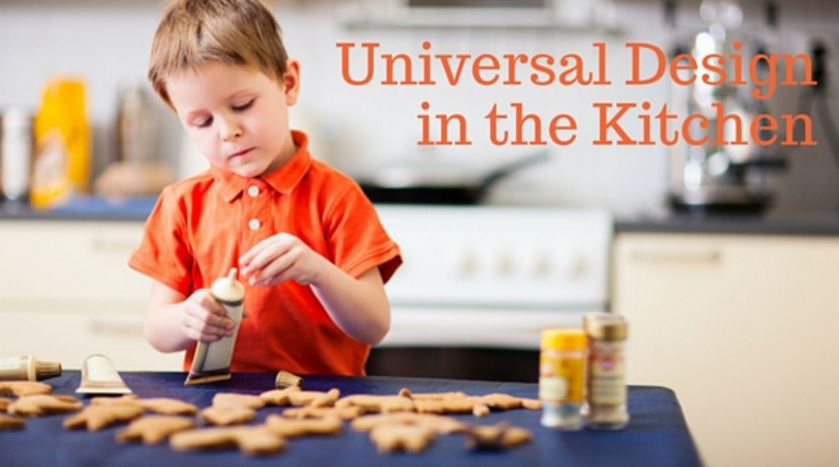Universal Design in the Kitchen
March 30, 2016
Some consumers are confused about what Universal Design is. While it is not strictly for the handicapped, Universal Design can be of great benefit for someone who has mobility and accessibility issues.
What is Universal Design?
Universal Design is design that is suited for all family members. No matter what the age or ability, it ensures that all family members can effectively use the space.
When we begin designing a space with Universal Design in mind, we think about how effortlessly and easily a task can be done. The goal is to minimize lifting, reaching and stooping – basically avoid any movements that have the potential of causing a person to become off-balance and hurt themselves.
You never know when life is going to throw you a curve and someone in the house ends up with a broken leg or temporarily confined to a wheelchair, or when you may need to care for a loved one in that situation inside your home. Universal Design helps you plan for every stage in your life – from younger ages to your golden years.
Universal Design in the Kitchen
In certain areas of your house, Universal Design can play a larger role in keeping your family safe and also enhance accessibility. Your kitchen is one of those areas (the bathroom is another).
Here are 7 Universal Design features to consider for your kitchen:
Faucets & Hardware. Does the faucet on the sink and the hardware on your cabinetry meet the “closed fist” test? In other words, can a person work them with a closed fist? Often older family members have arthritis or other issues that make it difficult to grip.
Offset single-lever faucets are ideal because they can be operated with one hand and do not require the person to reach behind the sink. Another option is an electronic touchless faucet that can be activated with the wave of a hand.
Flooring. Choose a flooring surface that is slip resistant and comfortable. When selecting tiles, in this instance, a smaller tile is better because it has less surface area (which minimizes slipping); or you can select a non-slip flooring like cork, which also provides some cushion – making it more comfortable to stand on. Also, there are products on the market that can be applied to tile or stone flooring that don’t take away from the appearance, yet add a tread to prevent slippage.
Counters. Design kitchen countertops, including the island, at varying heights. This allows family members who may need to sit to easily prepare meals, and further allows young children to be “helpers” at your side. From an aesthetic perspective, the variety of height also gives the space depth. The counters should also be solid surface for clean-up ease.
Clearance. You may want to give additional consideration for knee space at the sink, cooktop and meal prep areas for a seated option.
Storage. Select cabinetry where the items inside are reachable – such as pull-out draws for pots, pans and dishes, and pull-down shelves for overhead cabinetry that make it easier to find what you are looking for. Slide-out shelves, particularly under the sink, keep everything in its rightful place and minimize stooping/reaching to find cleaning supplies.
Lighting. As we get older, our eyesight starts to fail, so integrate plenty of overhead and under-cabinet lighting into your kitchen remodel, and select on/off switches that pass the “closed fist” test. Additionally, if you can, try to include more natural light (windows or skylights). Studies have shown that natural lighting has profound positive psychological benefits, especially for family members who can’t get outside as easily as they’d like.
Appliances. A number of appliances on the market today fit the Universal Design criteria and look phenomenal. When comparing appliances, it is smart to choose ones that have front-mounted controls, to eliminate reach. Here are some other items to consider when picking out specific appliances.
Microwaves – Drawer microwaves, as opposed to over-the-cooktop ones, are simply safer. It is much easier to slide something hot out of a microwave drawer than it is to lift it out from overhead. These are also convenient for younger family members who may be old enough to safely work the microwave but wouldn’t be tall enough to reach one that is higher.
Refrigerator – Side-by-side refrigerators/ freezers, particularly ones that have a gallon-sized storage shelf on the inside door, are ideal.
Dishwasher – Consider a dishwasher drawer you can load from the top.
Oven – Choose a wall oven that has a swinging door (similar to a refrigerator door) instead of one where the door hinges down to open.
Cooktop – Pick a cooking surface that is flat, which makes it easy to slide heavier pots and pans. You may also consider choosing a magnetic induction cooking surface because it doesn’t activate until you place the special cookware on top of the burner. Not only does it greatly reduce the chance of burns, but it also cooks faster.
When contemplating remodeling your kitchen, think of these Universal Design features you can add that will keep your kitchen approachable, comfortable and durable for all family members.
